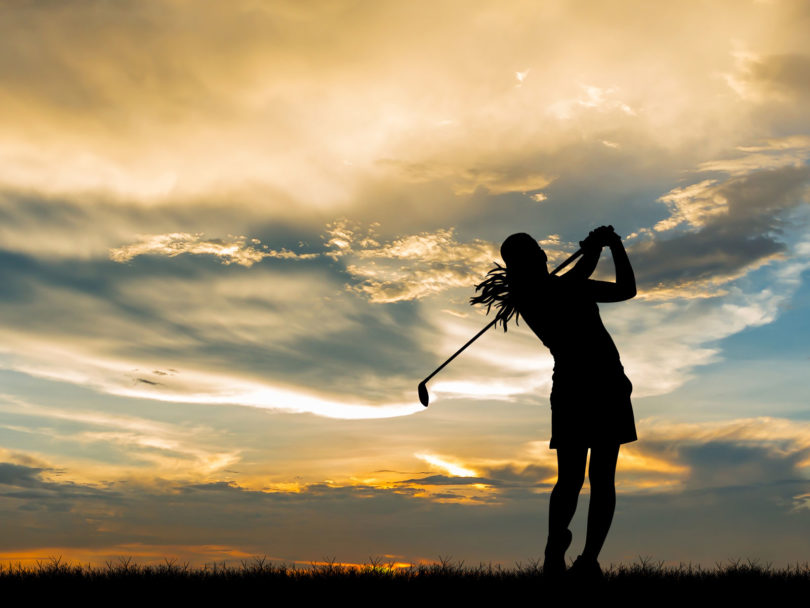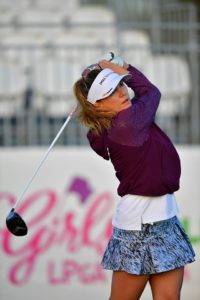After painful injuries, two LPGA golfers are back on the tour and ready to compete in Williamsburg
Like any sport, golf comes with its fair share of injuries. During the 2017 golf season, multiple LPGA golfers found themselves facing painful conditions and huge challenges to their careers.
With perseverance and hard work, Sydnee Michaels and Joanna Klatten fought back against their injuries to return to the game. The two will be among the world’s top female golfers teeing off at the Kingsmill Championship May 14-20 at Kingsmill Resort in Williamsburg, Va.
Nearly 150 golfers from 28 countries will hit the links to go after the title won last year by Lexi Thompson. Michaels, who hails from California, and Klatten, who is from Paris, France, were determined to not let injuries stop them from their chance to play Kingsmill’s River Course.
A Painful Back and a New Baby
In January 2017, Sydnee Michaels found herself sitting on the sidelines with intense back pain.
“I was hitting balls and, at impact, I felt a different pain than I’d ever experienced,” Michaels says. “I’ve had a sore back after being a golfer for years, but nothing like that.”
An MRI revealed she had a herniated disc as well as several bulging discs in her lower back. Complicating her path to recovery, Michaels discovered she was pregnant. While most people experiencing a herniated disc would get follow-up MRIs, take pain pills and work on strengthening their core, Michaels couldn’t do any of those things since they might have put her pregnancy at risk.
“It was really challenging,” Michaels says. “I did work out when I was pregnant, but I had to be very careful. It was all just ice and heat and rest.”
Working with her family and the tour doctors, she made the difficult decision to take the season off. She didn’t hit a ball for months, letting her back rest.
After she had her daughter, Isla, she got back into the gym to work on her core and change her swing to take pressure off her back. Thanks to her time off for pregnancy, she had plenty of time to adjust her stroke.
“It’s really hard to make a swing change while you are playing competitively in tournament golf,” Michaels says. “It’s near impossible. Even though I was pregnant and couldn’t hit like I normally would hit, the time off helped me retrain my muscles and swing without the pressure of playing tournaments.”
A recent MRI revealed that her back has improved, though she still has a few bulging discs. From now on, everything Michaels does in the gym and on the course is in an effort to prevent future back injuries. She completes a full warm-up before every round, receives regular chiropractic treatment and even uses a new treatment called post-electromagnetic field therapy to stimulate blood flow to her back.
After months of hard work, Michaels, 29, is back on the tour for her seventh year, this time with her daughter Isla in tow.
“My life on tour is completely changed,” Michaels says. “It’s awesome. I love bringing her with me.”
Shoulder Injury Tears Up Season
Michaels wasn’t the only LPGA golfer facing an injury in 2017. Joanna Klatten, a five-year veteran on the tour, experienced multiple shoulder problems.
During a Crossfit session in October, the 33-year-old first felt shooting pain in her shoulder. She had developed adhesive capsulitis — a condition in which the tissues around the shoulder joint thicken and stiffen. The condition causes painful and limited range of motion that can take up to 18 months to heal.
“I couldn’t lift my left shoulder,” Klatten recalls. “If I kept my arm straight and tried to lift it to the side, I couldn’t lift it more than like 45 degrees. I couldn’t even lift it parallel to the ground.”
Luckily, Klatten caught the condition so early that she was already seeing improved mobility within a month. But in January of this year, after an MRI, she got bad news: she had a ruptured tendon in her shoulder.
Either I was getting surgery or I had to get rehab every day to strengthen the shoulder so the tendon wasn’t used as much,” Klatten says.
She chose rehabilitation, going to physical therapy for an hour, four to five times per week, for more than three months. She had to complete several exercises, both in rehab and at home, with resistance bands and suspension trainers, which use gravity and one’s body weight to provide resistance.
“It was very painful exercise, no fun really,” Klatten says. “At first, I was wondering about how useful it was because in mid-February, I couldn’t see any improvement. It was still hurting as much.”
But by the beginning of March, Klatten felt improvements. By the end of March, her pain was gone. She was able to get back on the course, but her return wasn’t easy.
At first, it was pretty disastrous,” Klatten admits. “It had been so long since I hit a golf ball. The first few weeks were really bad, but, little by little, I’m getting it back.”
For the rest of her career, Klatten will have to keep up with her shoulder exercises to ensure that the joint stays strong. But returning to the tour was important to her, because she feels she has a lot left to accomplish as a pro golfer.
“One of my dreams would be to win Kingsmill because I love the golf course,” Klatten says. “I’m really looking forward to it.”









